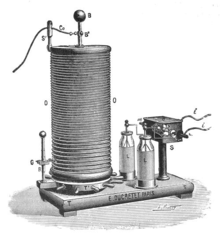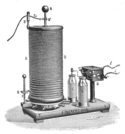Oudinspule


Die Oudinspule, auch als Oudin-Resonator bezeichnet, ist ein historischer elektrotechnischer Aufbau zur Erzeugung von hochfrequenter Wechselspannung. Die Bezeichnung geht auf den französischen Urologen Paul Marie Oudin zurück, welcher dazu erste Arbeiten 1899 zusammen mit dem französischen Physiker Jacques Arsène d’Arsonval durchführte.[1]
Aufbau und Funktionsprinzip
Im Prinzip ist die Oudinspule ein Tesla-Transformator ohne Eisenkern, eine Bauart eines Resonanztransformators. Im Gegensatz zum Tesla-Transformator wird nur eine Wicklung eingesetzt, die Oudinspule stellt einen so genannten Spartransformator dar. Die erzeugte Wechselspannung weist je nach System Frequenzen von einigen 10 kHz auf, die erzeugten Spannungen betragen bis zu einige 10 kV im Leerlauf. Die erzielbaren Leistungen sind vergleichsweise gering, bei Kontakt mit der Hochspannung bricht diese fast augenblicklich auf ungefährliche Werte zusammen.
Fast zur gleichen Zeit experimentierte Nikola Tesla an den nach ihm benannten Tesla-Transformatoren.
Anwendung
Anwendung fand die Oudinspule um 1900 und den Folgejahren als Diathermie-Heilgerät, zu einer Zeit als verschiedenartige elektromedizinische Experimente beliebt und neuartig waren. Die Behandlungsform ist wissenschaftlich nicht anerkannt, die Oudinspule wird teilweise noch heute zu pseudomedizinischen Zwecken verwendet.
Quellen
- ↑ Mihran Krikor Kassabian: Roentgen rays and electro-therapeutics. Lippincott Company, 1907 (Online).
Weblinks
- Pierre Dessapt: Raconte-moi la radio. Paul Marie OUDIN. 2007.
- Antonio Carlos M. de Queiroz: A Classical Tesla Coil with Top Load Tuning. 5. April 2006.
Auf dieser Seite verwendete Medien
An Oudin coil used for 'electrotherapy' treatment of a patient's knee around 1907. The Oudin coil (left), invented in 1893 by physician Paul Marie Oudin, was a spark-excited resonant transformer circuit similar to a Tesla coil which generated very high voltage, low current radio frequency electricity, used until perhaps 1925 in the Victorian era field of electrotherapy. The doctor holds an insulated electrode with sharp metal points (B) connected to the top high voltage terminal of the coil, which produced a luminous "brush" discharge (called "effluves") which was directed toward the patient's knee. The patient holds a ground electrode (A) attached to the bottom of the coil which made a return path for the current. The apparatus which drives the coil, a spark gap (S.M.) and two Leyden jar capacitors (L.J.), can be seen below the coil. Note the doctor's other hand (D, left) adjusting the tap on the coil. The motion of the electrode changed the capacitance of Oudin coils, throwing them out of resonance, so during use they had to be constantly adjusted to keep them in "tune".
Photo caption: "Treatment by the effluvation method. The condenser electrode, B, is in connection with the top of the resonator. Patient is seated upon an insulated platform, holding the electrode, A, which is the other pole, from the outer side of the Leyden jar, L J. (By grounding the outer side of the Leyden jar, A, the patient's insulation is unnecessary and better effluavation is attained.) S.M. is the spark-gap."
An Oudin coil, a resonant transformer circuit invented by Paul Marie Oudin in 1892, which generates high voltage, low current, high frequency AC electricity, used in the obsolete medical field of electrotherapy around the turn of the 20th century. The high voltage terminal at the top of the coil (B) was connected through a wire to a handheld electrode which produced luminous streamer arcs, which were applied to the body to treat various medical conditions. It was very similar to a Tesla coil, the only difference being that in the Oudin the output voltage was taken across both the primary and secondary windings of the coil in series, like an autotransformer.
An induction coil (not shown) provided high voltage 2 - 15 kV current to repeatedly charge the Leyden jar capacitors (L), which discharged by a spark across a spark gap in the box (S). This caused oscillating currents to flow through the heavy bottom primary winding of the Oudin coil (O), which formed a tuned circuit with the capacitors. This induced oscillating currents in the upper secondary winding, which resonated with the parasitic capacitance of the coil. The number of turns of the primary in the circuit could be adjusted by the tap (G) which changed its resonant frequency. When the primary and secondary circuits were adjusted to resonate at the same frequency very high voltage oscillations were induced in the secondary. Oudin coils could produce voltages of 250,000 to 1,000,000 volts. Instead of a single capacitor, two are used, one in each leg of the primary circuit, to completely isolate the patient from the power transformer voltage, which could be lethal.

